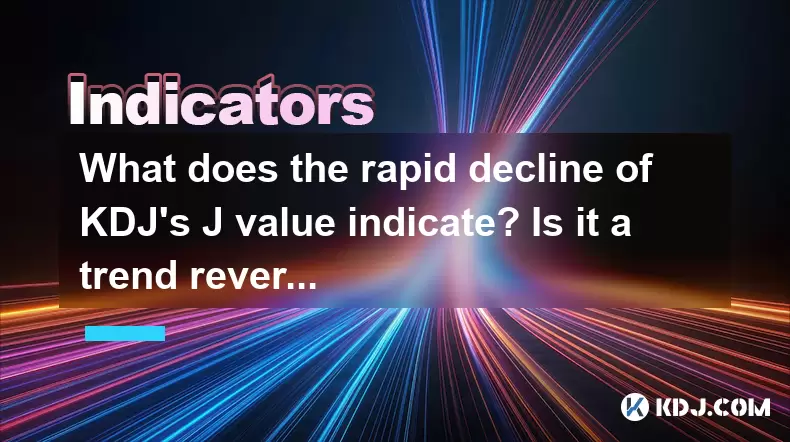-
 bitcoin
bitcoin $87959.907984 USD
1.34% -
 ethereum
ethereum $2920.497338 USD
3.04% -
 tether
tether $0.999775 USD
0.00% -
 xrp
xrp $2.237324 USD
8.12% -
 bnb
bnb $860.243768 USD
0.90% -
 solana
solana $138.089498 USD
5.43% -
 usd-coin
usd-coin $0.999807 USD
0.01% -
 tron
tron $0.272801 USD
-1.53% -
 dogecoin
dogecoin $0.150904 USD
2.96% -
 cardano
cardano $0.421635 USD
1.97% -
 hyperliquid
hyperliquid $32.152445 USD
2.23% -
 bitcoin-cash
bitcoin-cash $533.301069 USD
-1.94% -
 chainlink
chainlink $12.953417 USD
2.68% -
 unus-sed-leo
unus-sed-leo $9.535951 USD
0.73% -
 zcash
zcash $521.483386 USD
-2.87%
What does the rapid decline of KDJ's J value indicate? Is it a trend reversal signal?
A rapid decline in the KDJ's J value signals a shift from bullish to bearish momentum, often indicating a potential trend reversal in the cryptocurrency market.
May 25, 2025 at 05:21 am

The rapid decline of the KDJ's J value is a significant indicator within the realm of technical analysis, often used by traders in the cryptocurrency market to gauge potential trend reversals. The KDJ indicator, also known as the Stochastic Oscillator, is composed of three lines: K, D, and J. The J line is particularly important because it is more sensitive and can provide early signals of momentum shifts. When the J value experiences a rapid decline, it suggests that the market's momentum is shifting from bullish to bearish. This shift can be an early warning of a potential trend reversal, prompting traders to reassess their positions.
Understanding the KDJ Indicator
The KDJ indicator is a technical analysis tool that helps traders identify overbought and oversold conditions in the market. It consists of three lines: K, D, and J. The K line represents the fastest line, followed by the D line, which is a moving average of K. The J line is calculated as 3K - 2D, making it the most sensitive of the three. The values of K, D, and J typically range from 0 to 100. When the J value is above 80, it indicates an overbought condition, and when it is below 20, it signals an oversold condition. A rapid decline in the J value can indicate a shift in market sentiment and is often considered a precursor to a trend reversal.
The Significance of a Rapid Decline in J Value
A rapid decline in the J value is noteworthy because it suggests that the market's bullish momentum is weakening. This can be a critical signal for traders who are looking to exit long positions or enter short positions. The J line's sensitivity makes it a valuable tool for spotting early signs of a trend reversal. When the J value drops quickly from a high level, it indicates that the selling pressure is increasing, and the market may be poised for a downward move. This can be particularly useful in the volatile cryptocurrency market, where rapid price movements are common.
Is a Rapid Decline in J Value a Trend Reversal Signal?
While a rapid decline in the J value can be an early indicator of a trend reversal, it is not a definitive signal on its own. Traders should use it in conjunction with other technical indicators and market analysis tools to confirm the trend reversal. For instance, if the J value rapidly declines and crosses below the K and D lines, it can be a stronger signal of a bearish trend. Additionally, if this decline is accompanied by other bearish indicators such as a bearish divergence on the RSI or a break below a key support level, the likelihood of a trend reversal increases. Therefore, while the rapid decline in the J value is a significant signal, it should be part of a broader analysis strategy.
How to Interpret a Rapid Decline in J Value
Interpreting a rapid decline in the J value requires a comprehensive understanding of the market context. Traders should consider the following factors:
- Current Market Trend: If the market is in a strong uptrend, a rapid decline in the J value might be a warning sign of an impending correction. Conversely, if the market is already in a downtrend, it could signal a continuation of the bearish momentum.
- Volume: High trading volume accompanying the decline in the J value can reinforce the signal, indicating strong selling pressure.
- Other Technical Indicators: Confirming the signal with other indicators such as the Moving Average Convergence Divergence (MACD) or the Relative Strength Index (RSI) can provide a more robust analysis.
- Price Action: Observing how the price reacts to the rapid decline in the J value can offer additional insights. For example, if the price breaks below a key support level after the J value declines, it can confirm a bearish trend reversal.
Practical Example of Using the J Value in Trading
To illustrate how traders might use a rapid decline in the J value, consider the following hypothetical scenario involving a popular cryptocurrency like Bitcoin:
- Scenario: Bitcoin has been in a strong uptrend, with the J value hovering around 85. Suddenly, the J value drops to 50 within a short period.
- Analysis: This rapid decline suggests a potential shift in market momentum. Traders should look for confirmation signals such as increased selling volume, a bearish divergence on the RSI, or a break below a key support level.
- Action: If these confirmation signals are present, traders might consider closing long positions or entering short positions. For instance, if Bitcoin breaks below the $40,000 support level after the J value declines, it could be a strong indication of a trend reversal.
Using the J Value in Different Time Frames
The rapid decline in the J value can be observed across different time frames, each offering unique insights:
- Short-Term Time Frames (e.g., 15-minute chart): A rapid decline in the J value on a short-term chart can signal an immediate shift in momentum, useful for day traders looking to capitalize on short-term price movements.
- Medium-Term Time Frames (e.g., 1-hour chart): On a medium-term chart, a rapid decline in the J value can indicate a more significant trend reversal, relevant for swing traders who hold positions for several days or weeks.
- Long-Term Time Frames (e.g., daily chart): A rapid decline in the J value on a long-term chart can signal a major trend reversal, important for investors who are looking at the broader market direction over weeks or months.
Common Pitfalls When Using the J Value
While the rapid decline in the J value can be a valuable tool, traders should be aware of common pitfalls:
- False Signals: The J value can sometimes produce false signals, especially in highly volatile markets. Traders should always seek confirmation from other indicators.
- Overreliance: Relying solely on the J value without considering other market factors can lead to poor trading decisions. It should be used as part of a comprehensive trading strategy.
- Timing: The J value can sometimes signal a trend reversal before it actually occurs, leading to premature trading actions. Patience and confirmation are key.
Frequently Asked Questions
Q: Can the J value be used effectively in all cryptocurrency markets?A: The J value can be used in all cryptocurrency markets, but its effectiveness can vary depending on the liquidity and volatility of the specific market. In highly liquid markets like Bitcoin and Ethereum, the J value tends to be more reliable. In less liquid markets, the signals may be more prone to false positives due to erratic price movements.
Q: How often should traders check the J value?A: The frequency of checking the J value depends on the trader's strategy and time frame. Day traders might check it every few minutes on short-term charts, while swing traders and long-term investors might monitor it on hourly or daily charts. It's important to align the monitoring frequency with the trading strategy.
Q: Are there any specific settings for the KDJ indicator that are recommended for cryptocurrency trading?A: While there is no one-size-fits-all setting for the KDJ indicator, many traders use the default settings of 9, 3, and 3 for the K, D, and J periods, respectively. These settings can be adjusted based on the trader's preference and the specific market conditions. For more volatile cryptocurrencies, shorter periods might be more effective, while for less volatile markets, longer periods could provide more stable signals.
Q: How can the J value be integrated with other technical indicators for better analysis?A: The J value can be effectively integrated with other technical indicators to enhance analysis. For example, combining the J value with the MACD can help confirm trend reversals. If the J value rapidly declines and the MACD line crosses below the signal line, it can provide a strong bearish signal. Similarly, using the RSI alongside the J value can help identify overbought and oversold conditions more accurately. If the J value declines and the RSI is above 70, it can signal an impending bearish reversal.
Disclaimer:info@kdj.com
The information provided is not trading advice. kdj.com does not assume any responsibility for any investments made based on the information provided in this article. Cryptocurrencies are highly volatile and it is highly recommended that you invest with caution after thorough research!
If you believe that the content used on this website infringes your copyright, please contact us immediately (info@kdj.com) and we will delete it promptly.
- Big City Crypto Buzz: Cross-Chain Bridges, Multi-Chain Horizons, and Presales Paving the Future
- 2025-12-19 21:45:01
- Ray Dalio's Portfolio Prescription: Why Bitcoin and Gold Are Essential in a Debt-Ridden World
- 2025-12-19 01:35:01
- Taiwan's Bitcoin Trove: Criminal Investigations Unearth a Surprising Global Ranking
- 2025-12-19 01:30:02
- Coinbase's Bold Leap: Stocks, Prediction Markets, and the Future of Trading
- 2025-12-19 01:35:01
- Kaito, Kickstarter, and the Post-TGE Crash: Navigating Crypto's Volatile Launch Landscape
- 2025-12-19 01:15:01
- Jito Foundation's Onshoring Signals a New Dawn for Solana and Crypto Regulation in the US
- 2025-12-19 01:25:01
Related knowledge

How to Combine Japanese Candlesticks with Western Chart Patterns (like Head and Shoulders)?
Dec 04,2025 at 02:40pm
Understanding Japanese Candlesticks in Modern Trading1. Japanese candlesticks offer a visual representation of price movement within a specific timefr...

A Deep Dive into the Three Outside Up/Down Patterns for Crypto Traders.
Dec 17,2025 at 07:39am
Understanding the Three Outside Up Pattern in Crypto Markets1. The Three Outside Up pattern is a bullish reversal formation that typically appears at ...

Can a Gravestone Doji at a Key Resistance Level Signal a Perfect Short Entry?
Nov 28,2025 at 09:40pm
Understanding the Gravestone Doji in Technical Analysis1. The Gravestone Doji is a candlestick pattern characterized by an opening and closing price t...

What Do Overlapping Candlesticks Reveal About Support and Resistance in Crypto?
Dec 13,2025 at 08:39am
Understanding Overlapping Candlesticks in Crypto Charts1. Overlapping candlesticks occur when multiple price candles on a chart share similar high or ...

How to Tell if a Crypto Breakout is Real Using Candlestick and Volume Analysis?
Nov 28,2025 at 05:39am
Understanding the Anatomy of a Genuine Crypto Breakout1. A true breakout in the cryptocurrency market is not defined solely by price surpassing a resi...

The Definitive Guide to Entry and Exit Points Using Crypto Candlestick Patterns.
Nov 29,2025 at 06:59am
Understanding Bullish Reversal Patterns1. The hammer candlestick pattern typically appears at the end of a downtrend and signals a potential reversal....

How to Combine Japanese Candlesticks with Western Chart Patterns (like Head and Shoulders)?
Dec 04,2025 at 02:40pm
Understanding Japanese Candlesticks in Modern Trading1. Japanese candlesticks offer a visual representation of price movement within a specific timefr...

A Deep Dive into the Three Outside Up/Down Patterns for Crypto Traders.
Dec 17,2025 at 07:39am
Understanding the Three Outside Up Pattern in Crypto Markets1. The Three Outside Up pattern is a bullish reversal formation that typically appears at ...

Can a Gravestone Doji at a Key Resistance Level Signal a Perfect Short Entry?
Nov 28,2025 at 09:40pm
Understanding the Gravestone Doji in Technical Analysis1. The Gravestone Doji is a candlestick pattern characterized by an opening and closing price t...

What Do Overlapping Candlesticks Reveal About Support and Resistance in Crypto?
Dec 13,2025 at 08:39am
Understanding Overlapping Candlesticks in Crypto Charts1. Overlapping candlesticks occur when multiple price candles on a chart share similar high or ...

How to Tell if a Crypto Breakout is Real Using Candlestick and Volume Analysis?
Nov 28,2025 at 05:39am
Understanding the Anatomy of a Genuine Crypto Breakout1. A true breakout in the cryptocurrency market is not defined solely by price surpassing a resi...

The Definitive Guide to Entry and Exit Points Using Crypto Candlestick Patterns.
Nov 29,2025 at 06:59am
Understanding Bullish Reversal Patterns1. The hammer candlestick pattern typically appears at the end of a downtrend and signals a potential reversal....
See all articles









































































